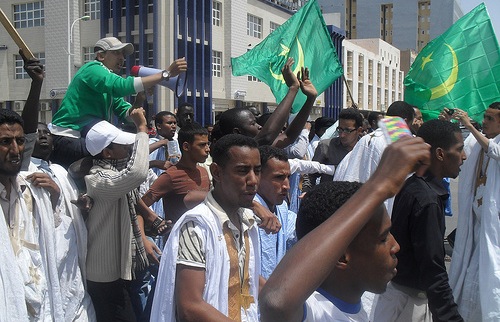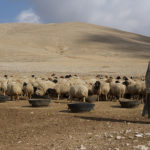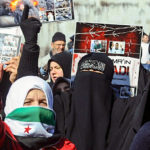Following the Tunisian and Egyptian revolutions of late 2010 and early 2011, commentators asked whether the “Arab Spring” would spark political upheavals south of the Sahara.
Since the beginning of 2011, several popular protest movements have indeed emerged in sub-Saharan African, including in Sudan, Mauritania, Uganda, Burkina Faso, and Senegal. Some of these movements have been extensions of the Arab Spring, while others have sprung primarily from local political dynamics. A cohesive “African Spring,” however, never took shape. In some cases, governments crushed dissent. In others, elections allowed dissenters outlets other than revolution. Several countries produced no significant mobilizations, sometimes because political transitions had already occurred in the past, notably during the wave of democratization that swept Africa in the early 1990s. Finally, several African countries in the Sahel zone(a) adjacent to North Africa have felt the impact of the Arab Spring not as inspiration for popular uprisings, but as yet another factor in domestic and regional destabilization.
Protests in Sudan and Mauritania, both Arab League members, emerged as part of the Arab Spring.(b) In both countries, protesters borrowed language and tactics from activists in North Africa, including self-immolations in Omdurman (Sudan) and Nouakchott (Mauritania) in January 2011. In fact, Sudan was one of the first Arab nations to witness major protests after the Tunisian revolution. In January and February 2011, students and opposition activists took to the streets, especially in Khartoum, calling for the fall of President Omar al Bashir, who took power in a 1989 coup. After crackdowns by security forces, the protests faded. In June and July 2012, the pattern recurred: activists returned to the streets to protest the deteriorating state of the economy and once more call for Bashir’s departure, only to meet renewed repression.1
Mauritania, too, saw protests early in the Arab Spring. Starting on February 25, 2011, youth activists and opposition partisans staged several large demonstrations. The movement called for reforms including greater transparency and a diminution of the military’s role in politics.2 The February 25th movement has intersected with other protest currents in the country, such as student demonstrations and protests by racial justice advocates. Mauritanian activists have propelled some changes, including a national dialogue initiative in late 2011, but have not shaken the foundations of President Mohamed Ould Abdel Aziz’s regime.
Movements in other sub-Saharan nations have resulted more from local political dynamics than from regional trends, although even in these cases some activists adopted the rhetoric of the Egyptian revolution and other Arab uprisings. These movements followed different trajectories. In Uganda, opposition leader Kizza Besigye, defeated in the February 2011 presidential election, championed the spring 2011 “Walk to Work” protests as a vehicle for voicing economic and political grievances against President Yoweri Museveni, who took power in 1986. Amid crackdowns, the movement lost momentum. In Burkina Faso, unpaid wages and rising food prices touched off mutinies by soldiers and protests by students and opposition groups. Yet the country’s different constituencies never coalesced into one protest movement, and the regime of President Blaise Compaore, who came to office in a 1987 coup, successfully suppressed mutinies while making reforms.
In Senegal, youth activists mobilized against two-term President Abdoulaye Wade beginning in 2011, creating the coalitions “Y En A Marre” (Enough is Enough) and “M23,” named after a large protest on June 23, 2011. Many Senegalese youth turned their energies toward defeating Wade at the ballot box in March 2012.3 His loss was followed by a peaceful transition of power to the newly elected Macky Sall. If there was an “African Spring,” Senegal is its success story. Yet what occurred in Senegal bears much greater similarity to Senegal’s own democratic transition of 2000 than to the Egyptian revolution and other events of the Arab Spring.(c)
In several Sahelian countries, the main impact of the Arab Spring has come not by way of political inspiration from Egypt, but as political fallout from Libya’s civil war. As the forces of Colonel Muammar Qadhafi and his opponents fought in Libya, migrants from sub-Saharan Africa became targets of suspicion and violence. Over 80,000 refugees fled Libya into Niger and Chad, a burden those fragile states were ill-equipped to receive.(d) The loss of remittances from migrant workers in Libya also hurt Sahelian economies.
On top of humanitarian and economic problems came military threats, as Libyan weapons and fighters who had sided with the Colonel, began traveling through the Sahara to places like Mali. When Tuareg dissidents launched an uprising in northern Mali in January 2012, their ranks reportedly included some men who had fought for Qadhafi. The chaos in Mali, which has included a military coup in the south and the takeover of the north by Islamists, is rooted in local histories of grievance and exclusion.4 But the aftermath of Libya’s civil war probably hastened and exacerbated the chaos. The situation in Mali has added to the difficulties that West Africa faces, including terrorism and the fear that Tuareg uprisings could spread to Niger.
As 2012 draws to a close, the impact of the Arab Spring on sub-Saharan Africa appears mixed. In some countries, state repression blocked protest movements from acquiring momentum. In many others, the revolutions in Tunisia and Egypt produced almost no echoes in local politics. Even where upheavals occurred, the connection to the Arab Spring was often thin. The most dramatic political transitions in sub-Saharan Africa over the past few years have come about not via grassroots revolutions inspired from abroad, but through elections and referenda (Senegal, Somalia, and the secession of South Sudan from Sudan), violence (Mali), and the unexpected deaths of heads of state (Ethiopia, Ghana, and Malawi). Where the Arab uprisings have had an impact, they sometimes gave sub-Saharan African activists new hope and a new language of dissent. Yet elsewhere, the fallout of war, turmoil, and revolution has contributed to instability and tragedy.
Endnotes
- Sherine Tadros (2012) “How Sudan’s Bashir Survived the Arab Spring,” Al Jazeera, 26 September.
- Khalid Lum (2011) “Mauritania’s Days of Rage,” Sada, 18 May.
- Catherine Kelly (2012) “Did the June 23 Movement Change Senegal?” Possible Futures.
- Bruce Whitehouse (2012) “What Went Wrong in Mali?” London Review of Books, 34(16): 17-18, 30 August.
Sidenotes
- (a) The Sahel region is a band stretching across the African continent immediately south of the Sahara Desert. It includes parts of Senegal, Mauritania, Mali, Burkina Faso, Niger, Nigeria, Chad, Sudan, and Eritrea.
- (b) The Arab League is a group of 22 countries in North Africa and the Middle East whose primary language is Arabic. The League, founded in 1945, aims to build relationships and coordinate policymaking between member countries.
- (c) Since decolonization in 1960, Senegal has had greater stability and success attempting democratic governance than many other African nations. After Abdoulaye Wade was elected president in 2000, Senegal experienced its first peaceful transition of power from one political party to another.
- (d) According to the UN High Commissioner for Refugees (UNHCR), since conflict escalated in Libya in February 2011, 660,000 Libyans fled the country and 200,000 were internally displaced.






